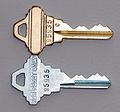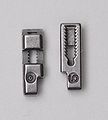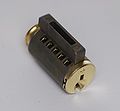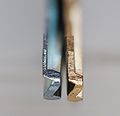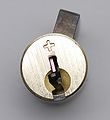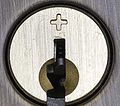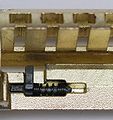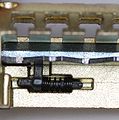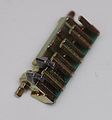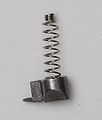Schlage SecureKey: Difference between revisions
mNo edit summary |
|||
| Line 20: | Line 20: | ||
== Principles of operation == | == Principles of operation == | ||
Schlage SecureKey locks feature 5 tumblers which need to be aligned properly to allow for the retraction of a single sidebar. Each tumbler consists of two parts: a "tongue pin" which rides on the key and a "slider" which has a cut away gate to allow for sidebar entry. The side of the slider opposite the gate features 10 narrow slits, one for each possible key depth, in which a corresponding male protrusion of the tongue pin remains. The tongue pins reside in a separate housing which is tilted away (clockwise) from the sliders during the reset procedure. When this occurs the male protrusion leaves the slider, allowing a new key to be inserted. Turning the plug back to the neutral position re-mates the two halves, leaving it to accept the new key. | |||
The blue reset key features a protrusion on the right side of the key. This protrusion depresses a spring-loaded blocking mechanism in the plug which in effect unlocks the housing containing the tongue pins. Only then can the tongue pin housing tilt away, separating the two halves. When separated the keyway is narrowed partially by the front most part of the tongue pin housing. This forces the use of the specially made blue reset keys, which are thinner to accommodate this. | |||
<div align="center"><gallery> | <div align="center"><gallery> | ||
Revision as of 20:46, 18 November 2010
Schlage SecureKey
| Schlage SecureKey | |
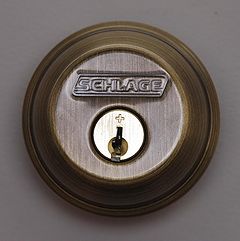 | |
| Name | Schlage SecureKey |
|---|---|
| Manufacturer | Schlage |
| Lock Type | Cylinder |
| Lock Design | Wafer,Hybrid |
| Year(s) Produced | 2010 - Present |
| Patent | US 12/138,950 |
The SecureKey is a user-rekeyable wafer lock made by Schlage. It uses five wafers that interact with a sidebar to provide protection against lockpicking and key bumping. The SecureKey is similar in design, functionality, and name to the Kwikset SmartKey. The rekeying mechanisms of both locks have considerable differences, however.
The SecureKey can be identified by the traditional Schlage C keyway warding and the + above the keyway.
Principles of operation
Schlage SecureKey locks feature 5 tumblers which need to be aligned properly to allow for the retraction of a single sidebar. Each tumbler consists of two parts: a "tongue pin" which rides on the key and a "slider" which has a cut away gate to allow for sidebar entry. The side of the slider opposite the gate features 10 narrow slits, one for each possible key depth, in which a corresponding male protrusion of the tongue pin remains. The tongue pins reside in a separate housing which is tilted away (clockwise) from the sliders during the reset procedure. When this occurs the male protrusion leaves the slider, allowing a new key to be inserted. Turning the plug back to the neutral position re-mates the two halves, leaving it to accept the new key.
The blue reset key features a protrusion on the right side of the key. This protrusion depresses a spring-loaded blocking mechanism in the plug which in effect unlocks the housing containing the tongue pins. Only then can the tongue pin housing tilt away, separating the two halves. When separated the keyway is narrowed partially by the front most part of the tongue pin housing. This forces the use of the specially made blue reset keys, which are thinner to accommodate this.
Rekeying instructions
In order to rekey the Secure Key you need to have a reset key for the current bitting and the desired bitting.
- Insert the reset key for the current bitting.
- Rotate the plug 10 ° to the left (counter clockwise). The plug should click into place as the guide pin housing disengages the wafers.
- Remove the reset key and insert the reset key for the desired bitting.
- Rotate the plug back to the default position and remove the reset key.
- Test the new working key.
Notes
- Do not return the plug to the default position without a reset key inserted.
- Do not attempt to reset the key bitting with a blank reset key. Some wafers may not engage the guide pins and the lock will be non-functional.
- If any errors occur you can always completely disassemble and resassemble the lock to return it to a working condition.
Disassembly instructions
- Remove the cam or C-clip.
- Remove the plug from the cylinder. You may have to raise the wafers so they do not block removal of the plug.
- From here the guide pin housing and guide pins can be removed, then the wafers and the guide pin housing spring.
Notes
- Using a working key to position wafers and guide pins is recommended when re-assembling the lock.
- The guide pin housing is difficult to re-assemble if you do not have prior experience with the lock.
Vulnerabilities
The SecureKey may be vulnerable to one or more of the following:
Notes
- The SecureKey cannot be bumped because it does not use pin-tumbler components.
- Various decoding and destructive attacks against the Kwikset SmartKey also work against the SecureKey.
Gallery
References
